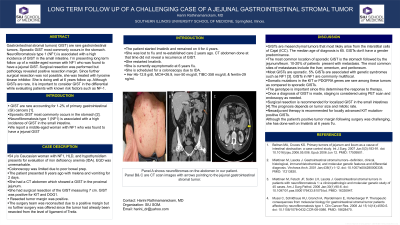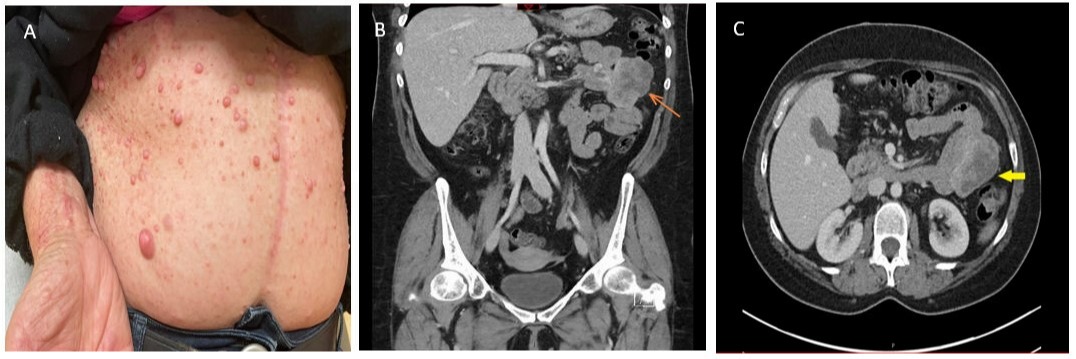Sunday Poster Session
Category: Small Intestine
P1332 - Long Term Follow-Up of a Challenging Case of Jejunal Gastrointestinal Stromal Tumor
Sunday, October 22, 2023
3:30 PM - 7:00 PM PT
Location: Exhibit Hall

Has Audio
- HR
Harini Rathinamanickam, MD
SIU School of Medicine
Springfield, IL
Presenting Author(s)
Harini Rathinamanickam, MD
SIU School of Medicine, Springfield, IL
Introduction: Gastrointestinal stromal tumors( GIST) are rare accounting for 1-2% of primary gastrointestinal (GI) cancers. Sporadic GIST most commonly occurs in the stomach. Neurofibromatosis type 1 (NF1) is associated with a high incidence of GIST in the small intestine. We report a middle-aged woman with NF1 who was found to have a jejunal GIST.
Case Description/Methods: 54 y/o Caucasian woman with NF1, HLD, and hypothyroidism presents for evaluation of iron deficiency anemia (IDA). EGD was unremarkable. Colonoscopy was limited due to poor bowel prep.
The patient presented 6 years ago with melena and vomiting for 2 days. She had a CT abdomen which showed a GIST in the proximal jejunum. She had surgical resection of the GIST measuring 7 cm. GIST was positive for KIT and DIOG1. Resected tumor margin was positive. The surgery team was reconsulted due to a positive margin but no further surgery was offered since the tumor had already been resected from the level of ligament of Trietz. The patient started Imatinib and remained on it for 4 years. She was lost to f/u and re-established care 2 years ago. CT abdomen done at that time did not reveal a recurrence of GIST. She restarted Imatinib.
She is currently asymptomatic at 6 years f/u. She will be scheduled for a colonoscopy due to IDA. Her Hb-12.8 g/dl, MCH=26.9, iron-50 mcg/dl, TIBC-358 mcg/dl, and ferritin-29 ng/ml.
Discussion: GISTs are mesenchymal tumors that most likely arise from the interstitial cells of Cajal (ICC). The median age of diagnosis is 65. GISTs don't have a gender predominance. The most common location of sporadic GIST is the stomach followed by the jejunum/ileum. 10-20% of patients present with metastasis. The most common sites of metastases include the liver, omentum, and peritoneum.
Most GISTs are sporadic. 5% GISTs are associated with genetic syndromes such as NF1. GISTs in NF1 are commonly multifocal. Somatic mutations in the KIT or PDGFRA genes are rare among these tumors as compared to sporadic GISTs. The genotype is important since this determines the response to therapy. Once a diagnosis of GIST is made, staging is considered using PET scan and endoscopy as needed. Surgical resection is recommended for localized GIST in the small intestines. The prognosis depends on tumor size and mitotic rate. Neoadjuvant therapy is recommended for locally advanced KIT mutation-positive GISTs.
Although the patient's positive tumor margin following surgery was challenging, she has done well on Imatinib at 6 years f/u.

Disclosures:
Harini Rathinamanickam, MD. P1332 - Long Term Follow-Up of a Challenging Case of Jejunal Gastrointestinal Stromal Tumor, ACG 2023 Annual Scientific Meeting Abstracts. Vancouver, BC, Canada: American College of Gastroenterology.
SIU School of Medicine, Springfield, IL
Introduction: Gastrointestinal stromal tumors( GIST) are rare accounting for 1-2% of primary gastrointestinal (GI) cancers. Sporadic GIST most commonly occurs in the stomach. Neurofibromatosis type 1 (NF1) is associated with a high incidence of GIST in the small intestine. We report a middle-aged woman with NF1 who was found to have a jejunal GIST.
Case Description/Methods: 54 y/o Caucasian woman with NF1, HLD, and hypothyroidism presents for evaluation of iron deficiency anemia (IDA). EGD was unremarkable. Colonoscopy was limited due to poor bowel prep.
The patient presented 6 years ago with melena and vomiting for 2 days. She had a CT abdomen which showed a GIST in the proximal jejunum. She had surgical resection of the GIST measuring 7 cm. GIST was positive for KIT and DIOG1. Resected tumor margin was positive. The surgery team was reconsulted due to a positive margin but no further surgery was offered since the tumor had already been resected from the level of ligament of Trietz. The patient started Imatinib and remained on it for 4 years. She was lost to f/u and re-established care 2 years ago. CT abdomen done at that time did not reveal a recurrence of GIST. She restarted Imatinib.
She is currently asymptomatic at 6 years f/u. She will be scheduled for a colonoscopy due to IDA. Her Hb-12.8 g/dl, MCH=26.9, iron-50 mcg/dl, TIBC-358 mcg/dl, and ferritin-29 ng/ml.
Discussion: GISTs are mesenchymal tumors that most likely arise from the interstitial cells of Cajal (ICC). The median age of diagnosis is 65. GISTs don't have a gender predominance. The most common location of sporadic GIST is the stomach followed by the jejunum/ileum. 10-20% of patients present with metastasis. The most common sites of metastases include the liver, omentum, and peritoneum.
Most GISTs are sporadic. 5% GISTs are associated with genetic syndromes such as NF1. GISTs in NF1 are commonly multifocal. Somatic mutations in the KIT or PDGFRA genes are rare among these tumors as compared to sporadic GISTs. The genotype is important since this determines the response to therapy. Once a diagnosis of GIST is made, staging is considered using PET scan and endoscopy as needed. Surgical resection is recommended for localized GIST in the small intestines. The prognosis depends on tumor size and mitotic rate. Neoadjuvant therapy is recommended for locally advanced KIT mutation-positive GISTs.
Although the patient's positive tumor margin following surgery was challenging, she has done well on Imatinib at 6 years f/u.

Figure: Panel A shows neurofibromas on the abdomen in our patient. Panel B and C are CT scan images with arrows pointing to the jejunal gastrointestinal stromal tumor.
Disclosures:
Harini Rathinamanickam indicated no relevant financial relationships.
Harini Rathinamanickam, MD. P1332 - Long Term Follow-Up of a Challenging Case of Jejunal Gastrointestinal Stromal Tumor, ACG 2023 Annual Scientific Meeting Abstracts. Vancouver, BC, Canada: American College of Gastroenterology.
